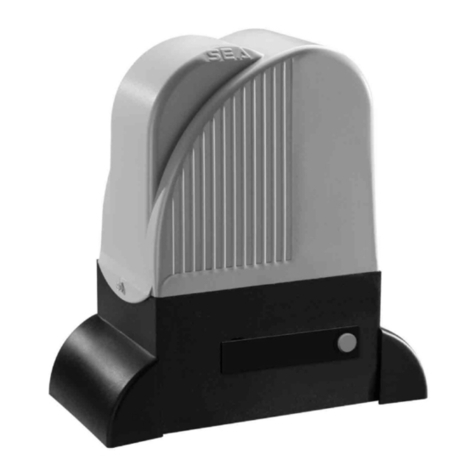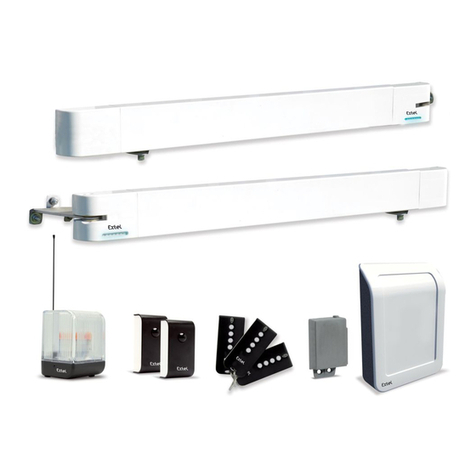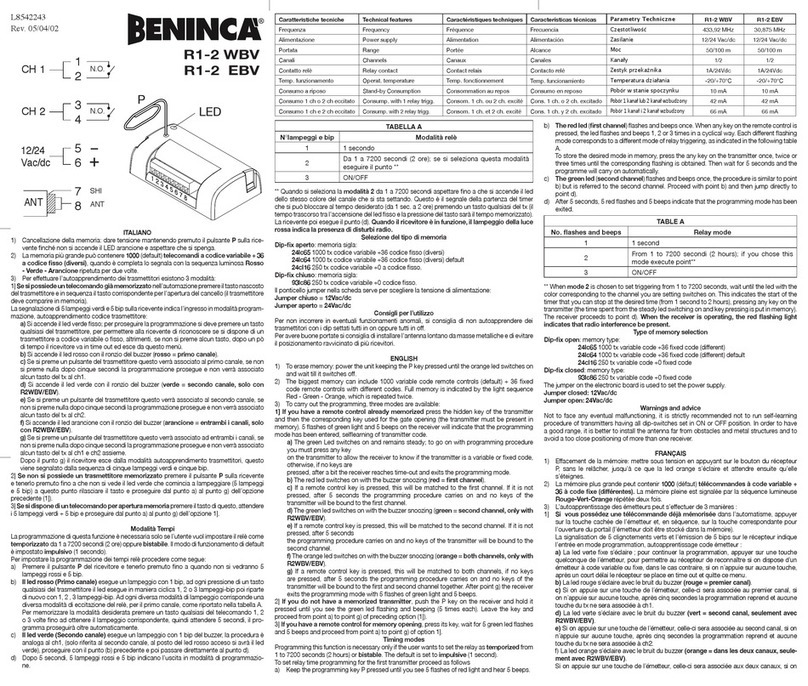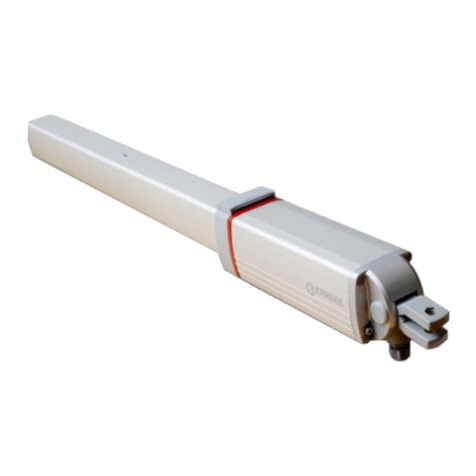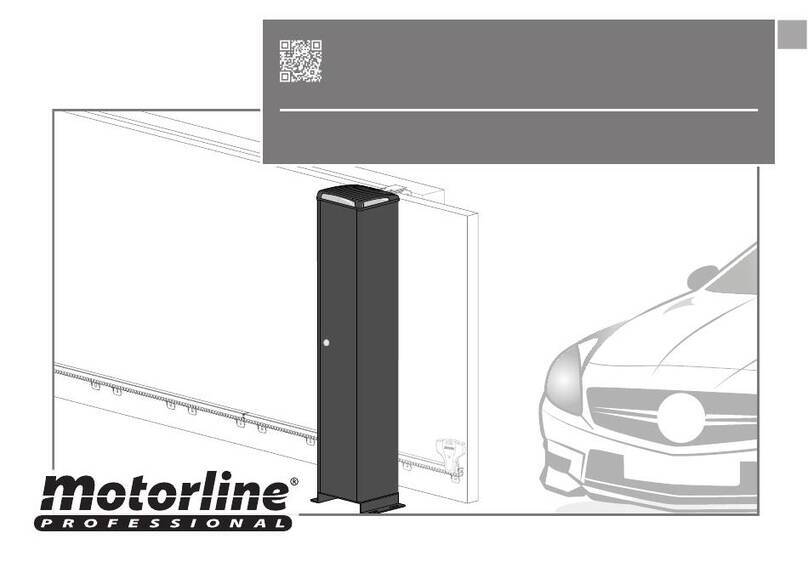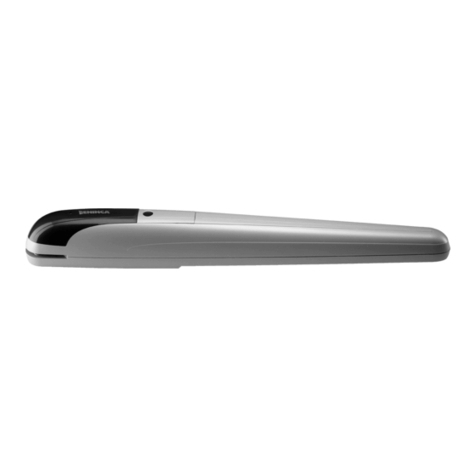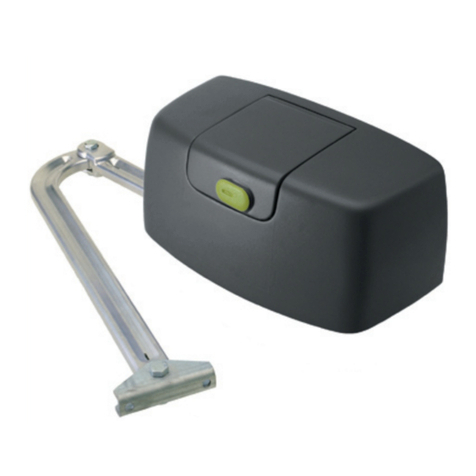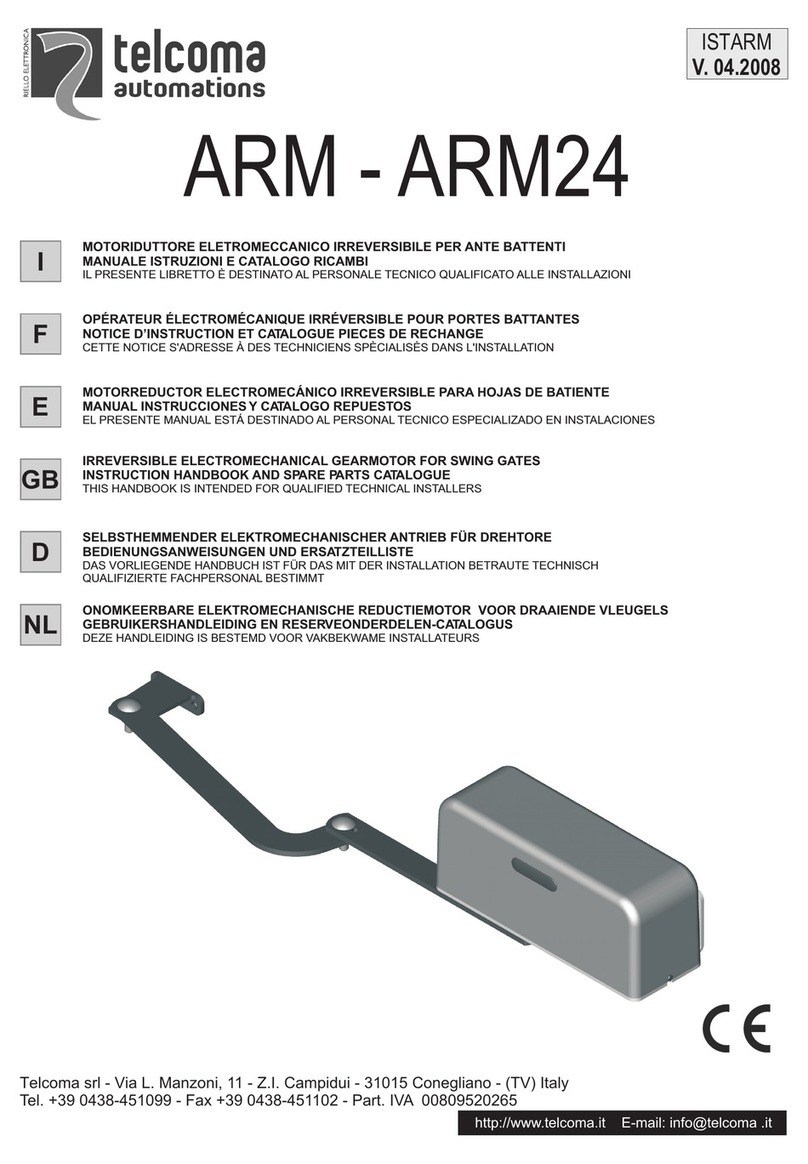SEA USA TAURUS RACK User manual

MOTOR REDUCERS FOR SLIDING GATES
67411231 REV. 04 - 07/2023
SEA USA Inc.
10850 N.W. 21st - unit 160 - Doral - Miami
FLORIDA (FL) 33172
Phone: ++ 1 - 305.594.1151
www.sea-usa.com
TAURUS RACK
TAURUS CHAIN GP

2
SAFETY INFORMATION
GENERAL SAFETY PRECAUTIONS
The following precautions are an integral and essential part of the product and must be supplied to the user;
Read them carefully as they contain important indications for the safe installation, use and maintenance.
1. These instructions must be kept and forwarded to all possible future users of the system.
2. This product must be used only for that which it has been expressly designed.
3. Any other use is to be considered improper and therefore dangerous.
4. The manufacturer cannot be held responsible for possible damage caused by improper or unreasonable use.
5. Avoid operating in the proximity of the hinges or moving mechanical parts.
6. Do not enter the path of the moving gate while in motion.
7. Do not obstruct the motion of the gate as this may cause a situation of danger.
8. Do not allow children to play or stay within the path of the moving gate.
9. Keep remote control or any other control devices out of the reach of children, in order to avoid possible involuntary
activation of the gate operator.
10. In case of break down or malfunctioning of the product, disconnect from the main power source. Do not attempt to
repair or intervene directly, contact only qualified personnel for repair.
11. Failure to comply with the above may create a situation of danger.
12. All cleaning, maintenance or repair work must be carried out by qualified personnel.
13. In order to guarantee that the system works efficiently and correctly it is important to have the manufacturer's
instructions on maintenance of the gate and operator carried out by qualified personnel.
14. In particular, regular checks are recommended in order to verify that the safety devices are operating correctly.
All installation, maintenance and repair work must be documented and made available to the user.
IMPORTANT SAFETY INSTRUCTIONS
WARNING – TO REDUCE THE RISK OF INJURY OR DEATH:
1. READ AND FOLLOW ALL INSTRUCTIONS.
2. Never let children operate or play with gate controls. Keep the remote control away from children.
3. Always keep people and objects away from the gate. NO ONE SHOULD CROSS THE PATH OF THE MOVING GATE.
4.Test the gate operator monthly. The gate MUST reverse on contact with a rigid object or stop when an object activates
the non-contact sensors. After adjusting the force or the limit of travel, retest the gate operator. Failure to adjust and
retest the gate operator properly can increase the risk of injury or death.
5. Use the emergency release only when the gate is not moving
6. KEEP GATES PROPERLY MAINTAINED. Read the owner’s manual. Have a qualified service person make repairs to gate
hardware.
7. The entrance is for vehicles only. PEDESTRIANS MUST USE SEPARATE ENTRANCE.
8. Every gate operator installation MUST have secondary protection devices against entrapments, such as edge
sensors and photo beams more in particular in places where the risk of entrapments is more likely to occur
9. SAVE THESE INSTRUCTIONS
GENERAL SAFETY INFORMATION
An appliance shall be provided with an instruction manual.
The instruction manual shall give instructions for the installation, operation, and user maintenance of the appliance.
The installation instructions shall specify the need for a grounding-type receptacle for connection to the supply and
shall stress the importance of proper grounding.
The installation instructions shall inform the installer that permanent wiring is to be employed as required by local
codes, and instructions for conversion to permanent wiring shall be supplied.
INFORMATION SHALL BE SUPPLIED WITH A GATE OPERATOR FOR:
a. The required installation and adjustment of all devices and systems to effect the primary and secondary protection
against entrapment (where included with the operator).
b. The intended connections for all devices and systems to effect the primary and secondary protection against en-
trapment. The information shall be supplied in the instruction manual, wiring diagrams, separate instructions, or the
equivalent.
VEHICULAR GATE OPERATORS (OR SYSTEMS)
A vehicular gate operator shall be provided with the information in the instruction manual that defines the different
vehicular gate operator Class categories and give examples of each usage. The manual shall also indicate the use for
which the particular unit is intended as defined in Glossary, Section 3. The installation instructions for vehicular gate
operators shall include information on the Types of gate for which the operator is intended.

3
A gate operator shall be provided with the specific instructions describing all user adjustments required for proper
operation of the gate. Detailed instructions shall be provided regarding user adjustment of any clutch or pressure relief
adjustments provided. The instructions shall also indicate the need for periodic checking and adjustment by a qualified
technician of the control mechanism for force, speed, and sensitivity.
Instructions for the installation, adjustment, and wiring of external controls and devices serving as required protection
against entrapment shall be provided with the operator when such controls are shipped with the operator.
Instructions regarding intended installation of the gate operator shall be supplied as part of the installation instructions
or as a separate document. The following instructions or the equivalent shall be supplied where applicable:
IMPORTANT INSTALLATION INSTRUCTIONS
1. Install the gate operator only when:
a. The operator is appropriate for the construction of the gate and the usage Class of the gate
b. All openings of a horizontal slide gate are guarded or screened from the bottom of the gate to a minimum of 4 feet
(1.22 m) above the ground to prevent a 2-1/4 inches (57.2 mm) diameter sphere from passing through the openings
anywhere in the gate, and in that portion of the adjacent fence that the gate covers in the open position
c. All exposed pinch points are eliminated or guarded
d. Guarding is supplied for exposed rollers
2. The operator is intended for installation only on gates used for vehicles. Pedestrians must be supplied with a
separate access opening. The partial access opening shall be designed to promote pedestrian usage. Locate the gate
such that persons will not come in contact with the vehicular gate during the entire path of travel of the vehicular gate.
3. The gate must be installed in a location so that enough clearance is supplied between the gate and adjacent
structures when opening and closing to reduce the risk of entrapment. Swinging gates shall not open into public access
areas.
4. The gate must be properly installed and work freely in both directions prior to the installation of the gate operator. Do
not over-tighten the operator clutch or pressure relief valve to compensate for a damaged gate.
5. The gate operator controls must be placed so that the user has full view of the gate area when the gate is moving and
AWAY FROM THE GATE PATH PERIMETER.
6. Controls intended for user activation must be located at least six feet (6’) away from any moving part of the gate and
where the user is prevented from reaching over, under, around or through the gate to operate the controls. Outdoor or
easily accessible controls shall have a security feature to prevent unauthorized use.
7. The Stop and/or Reset button must be located in the line-of-sight of the gate. Activation of the reset control shall not
cause the operator to start.
8. A minimum of two (2) WARNING SIGNS shall be installed, one on each side of the gate where easily visible
9. FOR GATE OPERATORS UTILIZING A NON-CONTACT SENSOR:
a. See instructions on the placement of non-contact sensors for each Type of application
b. Care shall be exercised to reduce the risk of nuisance tripping, such as when a vehicle, trips the sensor while the
gate is still moving
c. One or more non-contact sensors shall be located where the risk of entrapment or obstruction exists, such as the
perimeter reachable by a moving gate or barrier
10. FOR A GATE OPERATOR UTILIZING A CONTACT SENSOR:
a. One or more contact sensors shall be located where the risk of entrapment or obstruction exists, such as at the
leading edge, trailing edge, and post-mounted both inside and outside of a vehicular horizontal slide gate.
b. One or more contact sensors shall be located at the bottom edge of a vehicular vertical lift gate.
c. One or more contact sensors shall be located at the pinch point of a vehicular vertical pivot gate.
d. A hardwired contact sensor shall be located and its wiring arranged so that the communication between the sensor
and the gate operator is not subjected to mechanical damage.
e. A wireless contact sensor such as one that transmits radio frequency (RF) signals to the gate operator for
entrapment protection functions shall be located where the transmission of the signals is not obstructed or
impeded by building structures, natural landscaping or similar obstruction. A wireless contact sensor shall function
under the intended end-use conditions.
f. One or more contact sensors shall be located on the inside and outside leading edge of a swing gate. Additionally, if
the bottom edge of a swing gate is greater than 6 inches (152 mm) above the ground at any point in its arc of travel,
one or more contact sensors shall be located on the bottom edge.
g. One or more contact sensors shall be located at the bottom edge of a vertical barrier (arm).
INSTRUCTION REGARDING INTENDED OPERATION OF THE GATE OPERATOR SHALL BE PROVIDED AS PART OF THE USER
INSTRUCTIONS OR AS A SEPARATE DOCUMENT. THE FOLLOWING INSTRUCTIONS OR THE EQUIVALENT SHALL BE PROVIDED

4
NOTICE
As for misunderstandings that may arise refer to your area distributor or call our help desk. These instructions are part
of the device and must be kept in a well-known place. The installer shall follow the provided instructions thoroughly.
SEA products must only be used to automate doors, gates and wings. Any initiative taken without SEA USA Inc. explicit
authorization will preserve the manufacturer from whatsoever responsibility. The installer shall provide warning
notices on not assessable further risks. SEA USA Inc. in its relentless aim to improve the products, is allowed to make
whatsoever adjustment without giving notice. This doesn’t oblige SEA to up-grade the past production. SEA USA Inc.
cannot be deemed responsible for any damage or accident caused by product breaking, being damages or accidents
due to a failure to comply with the instructions herein. The guarantee will be void and the manufacturer responsibility
will be nullified if SEA USA Inc. original spare parts are not being used. The electrical installation shall be carried out by
a professional technician who will release documentation as requested by the laws in force. Packaging materials such
as plastic bags, foam polystyrene, nails etc must be kept out of children’s reach as dangers may arise.
TO RESPECT THE LAWS IN FORCE IT IS RECOMMENDED TO USE THE ENCODER WITH THE ELECTRONIC CONTROL UNIT
UL 325 ED. 6th ENTRAPMENT PROTECTION REQUIREMENTS
VEHICULAR GATE OPERATOR CLASSES
Residential Vehicular Gate Operator-Class I: A vehicular gate operator (or system) intended for use in garages or
parking areas associated with a residence of one-to-four single families
Commercial/General Access Vehicular Gate Operator-Class II: A vehicular gate operator (or system) intended for
use in a commercial location or building such as a multi-family housing unit (five or more single family units), hotel,
garages, retail store, or other buildings accessible by or servicing the general public
Industrial/Limited Access Vehicular Gate Operator–Class III: A vehicular gate operator (or system) intended for
use in an industrial location or building such as a factory or loading dock area or other locations not accessible by or
intended to service the general public
Restricted Access Vehicular Gate Operator–Class IV: A vehicular gate operator (or system) intended for use in an
industrial location or building such as a factory or loading dock area or other locations not accessible by or intended to
service the general public
THIS VEHICULAR GATE OPERATOR MUST BE INSTALLED WITH AT LEAST TWO INDEPENDENT ENTRAPMENT PROTECTION MEANS
AS SPECIFIED IN THE TABLE BELOW
HORIZONTAL SLIDE
VERTICAL LIFT - VERTICAL PIVOT
ENTRAPMENT
PROTECTION
TYPES
TYPE A
TYPE B1
TYPE B2
TYPE C
Inherent entrapment protection system
Non-contact sensors such as photoelectric sensors or equivalents
Contact sensors such as edge sensors or equivalent devices
Inherent force limiting, inherent adjustable clutch or inherent pressure relief device
TYPE D Actuating device requiring constant pressure to maintain opening or closing motion of the gate
SWING
VERTICAL BARRIER (ARM)
A , B1*, B2* or D A , B1*, B2*, C or D
GATE OPERATOR CATEGORY (Effective January, 12 2016)
NOTES:
1. The same type of device shall not be used for both entrapment protection means. Use of a single device to cover
both the opening and closing directions is in accordance with the requirement; however, a single device is not required
to cover both directions. Tice installer is required to install entrapment protection devices in each entrapment zone
2. FOR VERITICAL BARRIERS ONLY: Barrier gate operators (arm) that is not intended to move toward a rigid object
closer than 16 inches (406 mm) are not required to be provided with a means of entrapment protection
* B1 and B2 means of entrapment protection MUST be MONITORED

5
PERIODIC MAINTENANCE
Starting on Jan. 12, 2016, new UL 325 changes take effect, bringing a series of new mandates for the gate
operator industry. Here’s a quick guide to the key modifications
1. ENTRAPMENT-PROTECTION DEVICES: Gate operators are required to have a minimum of two independent means of
entrapment protection where the risk of entrapment or obstruction exists. A manufacturer can use two inherent-type
systems, two external-type systems, or an inherent and an external system to meet the requirement. However, the
same type of device cannot be used for both means of protection.
2. MONITORING REQUIRED: An external non-contact sensor or contact sensor may be used as a means of entrapment
protection. However, the sensor must be monitored once every cycle for:
a. the correct connection to the operator
b. the correct operation of the sensor
If the device is not present, not functioning, or is shorted, then the gate operator can only be operated by constant
pressure on the control device. Portable wireless controls will not function in this case.
3. ENTRAPMENT RISK IDENTIFICATION: As in the past, it’s up to the installer to examine the installation and determine
where a risk of entrapment or obstruction exists. Manufacturers are required to provide instructions for the placement
of external devices, but they give only examples of suggested entrapment protection in their installation manuals. If the
installer identifies a risk of entrapment or obstruction, at least two independent means of entrapment protection are
required.
4.TERMINOLOGY CHANGE: The terms «primary» and «secondary» have been removed in the description of entrapment
protection devices. This was done to emphasize that all entrapment protection devices are equally important.
5. THE END OF TYPE E: Type E (audible alarm) devices can no longer be used for entrapment protection. This change
was made because the Type E device is really a warning device, not an entrapment-protection device. Also, all gate
operator classes are now required to have an audio alarm that sounds when two successive obstructions are
encountered via a contact-type system.
6. ACCESS CONTROL LOCATION FOR EMERGENCY USE: An exception has been added in the manufacturer’s instructional
requirements for the location of controls that operate the gate.
The instructional requirements state that these controls must be at least 6' away from any moving part of the gate. In
the new exception, «Emergency access controls only accessible by authorized personnel (e.g., fire, police, EMS) may
be placed at any location in the line-of-sight of the gate».
7. BARRIER-ARM OPERATOR EXCEPTION: An exception has changed for barrier-arm gate operators requiring entrapment
protection. The previous exception stated that a barrier-arm operator did not require entrapment protection if the arm
did not move toward a rigid object closer than 2". The distance has been reduced to 16" so it more closely aligns with
the industry-defined entrapment protection provisions in ASTM F2200.
8. GATE OPERATOR CLASS II AND CLASS III DEFINITIONS: The definitions for installation classes for gate operators were
modified. Class II now includes commercial locations accessible to the general public. Class III was refined to specify
industrial locations not accessible to the general public. These changes, while seemingly minor, may affect which gate
operator is suitable for a particular installation location.
CHANGES TO UL 325 ED. 6TH FOR GATE OPERATORS
Clean and grease parts in movement (wheels, counter-connecting rod, release, etc.)
Check for corroded parts and replace if necessary
Check if the screws and all mounting hardwares are properly tighten
Check the conditions of wear and tear of the devices in movement
Check the correct drain of the rainwater
Check the integrity of the connection cables
Inspect the track for any signs of cracking or separation
Ensure that the gate moves freely
YEARLY
YEARLY
YEARLY
YEARLY
YEARLY
YEARLY
YEARLY
YEARLY
Check and confirm the proper operation of all safety devices (photocells, edge sensors etc)
Check and confirm the operation of all installed accessories
Check and confirm the operation of the manual release
Check the battery conditions and be sure that connections are free of corrosion
Verify the functionally of the battery backup, or power failure option
TURNING OFF THE POWER
BY MAIN SOURCE TURNED-OFF
TURNING ON THE POWER
YEARLY
YEARLY
YEARLY
YEARLY
YEARLY
ALL THE ABOVE DESCRIBED OPERATIONS MUST BE MADE EXCLUSIVELY BY AN AUTHORIZED INSTALLER
This manual suits for next models
1
Table of contents
Other SEA USA Gate Opener manuals
Popular Gate Opener manuals by other brands
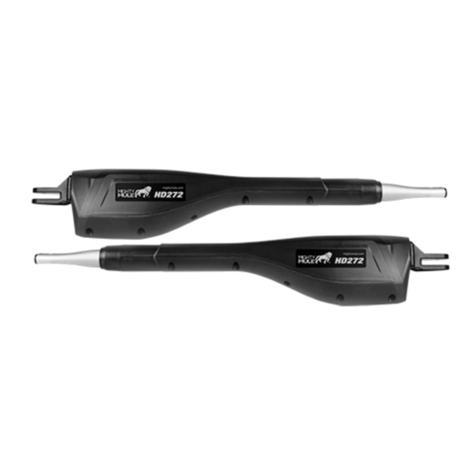
Nortek Security & Control
Nortek Security & Control Mighty Mule HD272 installation manual

tousek
tousek TURN 10 Installation and operating instructions

SOMFY
SOMFY AXOVIA 220B RTS installation instructions
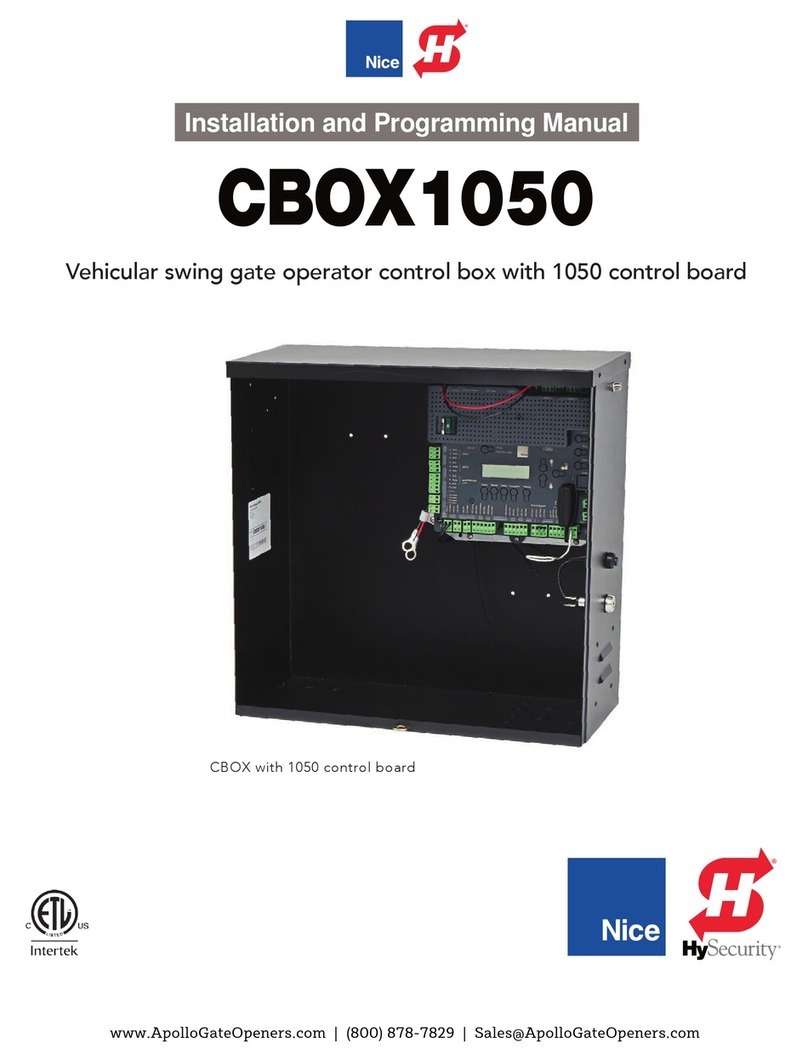
Nice HySecurity
Nice HySecurity CBOX1050 Installation and programming manual
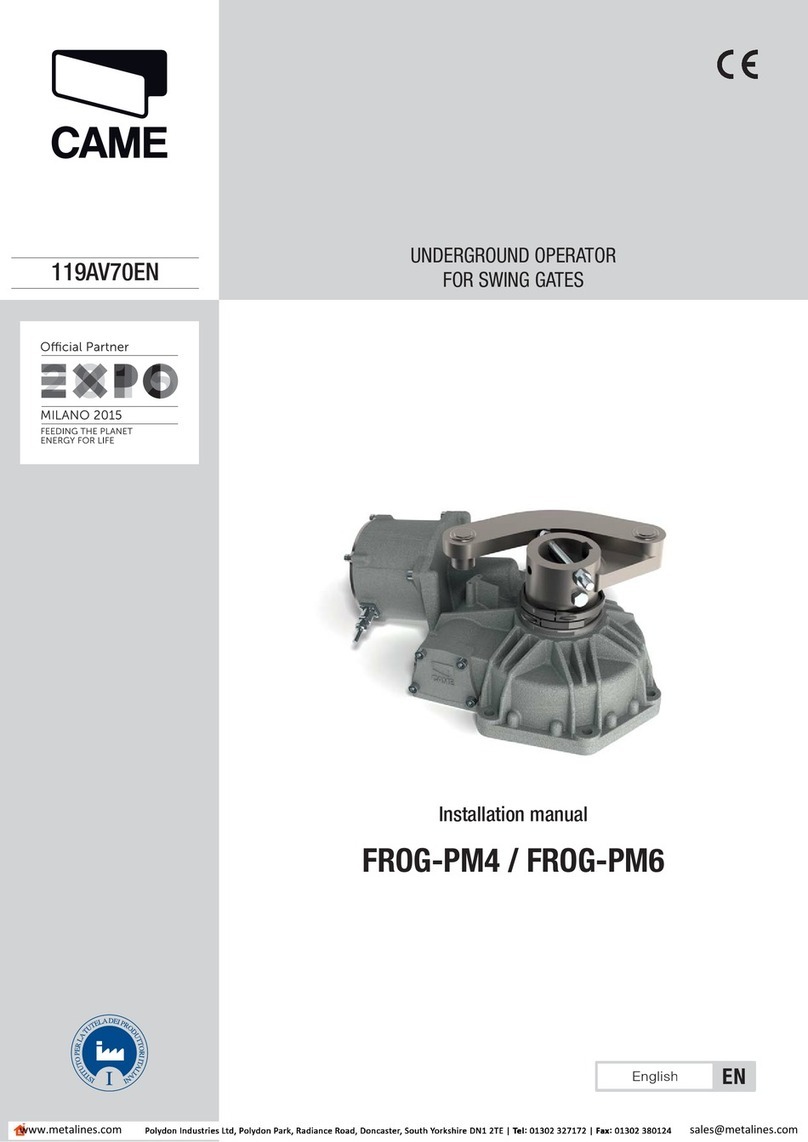
CAME
CAME FROG-PM4 installation manual

Aprimatic
Aprimatic ONDA 500 installation instructions

